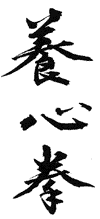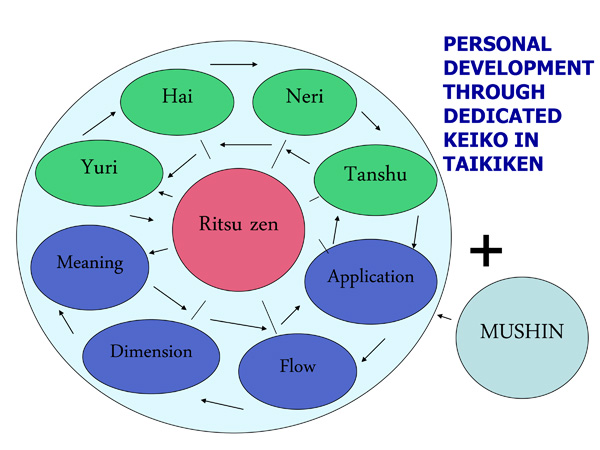
| SHIN-NEN-KEIKO, 15 January 2011 |  Yoshinken 
The First training (Keiko) of the new year |
||||
| Saturday – arrival and introduction We were greeted by Sensei Marshall and his wife Pilar, who were both busy preparing the house for the arrival of a team of hungry and enthusiastic kenpoka. Immediately, our knowledge of the budo literature and the terminology within Yoshinken was put to the test as we were given a written exam.
Sushi and dessert was then served, and to celebrate the efforts of Sensei Åke and Sempai André during the past ten years of Yoshinken, each of them were given a basket with very select contents. Sensei Marshall was in turn given a book about birds (complete with sounds) as well as the BBC film series “Life”, both reflecting his great interest in animals and nature!
This was followed by picture presentations. For the third year in a row, all members had selected pictures and put words to them. We all agreed that the quality had improved, Sensei said that we had “raised the bar”, demonstrating with his hand how the presentations had reached a higher level. We all shared the feeling that this is a unique and fruitful part of the community around Yoshinken, in which our different personalities, interests and strengths can be given adequate expression. Saturday evening also included an important theoretical presentation by Sensei Marshall. He held a lecture on a new element in our practice which he has developed during the year and first introduced during the Gasshuku last summer. It is a model of the relationship between ritsu zen and our basic training sequence (yuri, hai, neri and tanshu), our themes (meaning, dimensions, flow and applications) and mushin (see below). The model displays the relationship between the different elements of our practice in a new way. This has practical consequences for the organization of keiko, since the model provides a clear structure for testing, enquiring and developing different aspects of one´s energy and moving. The model provides a combination of structure and freedom – one can enter practice with a particular question or problem and find a personal answer by following the sequence. As a system for budo practice, I see this as unique, and it will be very interesting to test it in practice during the coming year. It is, however, also clear that it demands dedication and continuous practice of ritsu zen and the other basic elements, since these make up the necessary fundament for working with one´s own questions. The practice of the basic elements will in turn profit from the process. The presentation of the model was much interesting and needed! Another aspect of this model is that mushin has received a new position, which Sensei discussed in depth. Here he became serious – mushin is a concept difficult to describe, but it can be understood as being one step from death, a state one enters when life is at stake. This is no easy thing to relate to. I came to think about the inscription found on the wooden gong at the entrance of many zen temples, which reminds the monks of the urgency of the question of life and death - every time the gong is struck. How we understand the role and meaning of mushin has implications for the very basis of our practice and for budo in general. What are we to strive for? What do we prepare ourselves for? Many practitioners create detailed systems of combat, and practice particular moves to perfection, but what is the meaning?Mushin is nothing we can take for granted as a result of our practice and it cannot be built into a system. Sensei described his strive to affirm the origins in bujutsu without having any illusions about being able to live and practice as in historical times. We have to practice in a way which is suitable for contemporary conditions. Regrettably, it is not possible to describe all the ideas that Sensei shared regarding mushin here, but especially worthy of mention is the stories about Sensei Donn Draeger and Sawai Sensei, two persons who have been a great influence on the development of Yoshinken. Their presence was felt in our honbu-dojo through all the photographs on the walls. We owe a lot to Donn Draeger for being part of assuring that budo was allowed at all by the American government in Japan after the Second World War. Despite having lived through horrible conditions and experiences during war, and the fact that Sensei Draeger later dissociated himself from the use and practice of firearms, these budo masters both saw something different in their practice. This is highly interesting, and I come to think of a quote from the Swedish humanist scholar and diplomat Sture Linnér, who also found himself close to death at several occasions but unfortunately passed away last year: “Homer shows, as the first, that the line between barbarism and civilization cannot be drawn between different peoples, but within each people, and within each human.” These questions are not just for budoka, but as a theme in the writings of Homer, the first known author in western literature, they should be relevant for everybody. I understand Sensei´s stories regarding these matters as a way of urging us to keep questioning and try to deepen and enrich our understanding.
|
Sunday – Keiko
As usually we had good luck with the weather, and the pouring rain during the night turned to fog which later cleared up. After kampai (cheers) in sake, keiko started in ritsu zen at 8 o´clock. As in the last Shin nen keiko, we took high position (similar to the beginning position of karate kata Kanku/Kushanku). This is a suitable start of the year - the contact with the sky gives inspiration and one can be filled with the feeling of new possibilities. After ritsu zen and han zen we also directed our energy downwards in the positions holding the tiger and the dragon. I had the sentence from master Wang Xiangzhai "you feel a power as great as if heaven and earth were fighting” in my thoughts, and we really got to feel the importance of the ground when the snow time and time again tricked our feet during the annual meeting in tui shou. Too much force makes you slip and go down. The snow however also showed its soft and kind aspect and became a tatami which softened our falls without making us all too damp when we moved to new exercises. In pairs, we started back to back with one knee on the ground, beyond reach. The aim was to take control.
In the second part of keiko we went inside. The dojo, filled with enthusiastic kenpoka, soon turned into a sauna with steamy windows, which gave an impression of training in Japanese heat, intense but with control. We started out with defense against attacks to the throat and mid section. Here we got a feeling for the most direct and explosive side of Yoshinken. During the circumstances it was a challenge for us all to give full expression of force without causing injuries, all while pouring sweat made arms and faces slippery. The flower pots on the floor were definitely at risk. Sensei time and time again emphasised hakke – not to attempt to push aside the arms of the attacker but to use mental intention and explosively move in for control. In the continuing exercises we were encouraged to visualize the mythological dragon, linking to the talk about mushin the night before. The message was to not back down or give in but to completely focus on explosive outmaneuvering… This points to a focus on application and the further development efficiency in applications over the coming year, something which is central to Yoshinken as a defense method.
Closing and good bye We were all happy to see that injuries and damage to photos and furnishing of our honbu dojo had been avoided, despite rather intense wrestling with lifts and takedowns. Keiko was closed in a very good spirit! This was followed by a brunch and all members shared their final thoughts. Pilar, who participated as photographer and ”moral support”, as she explained it, listened with interest. In spite of the absence of a few fellow members, a warm feeling made this to an extra memorable weekend. The feeling of wanting to take the training seriously during the coming year was evident, which is part of the intention with meeting up for the first training session of the year – Shin nen keiko. We thank Sensei Marshall and Pilar for this very nice start of the new year!
Summary and reflections by Patrik Lilja.
|
||||
|
|||||








